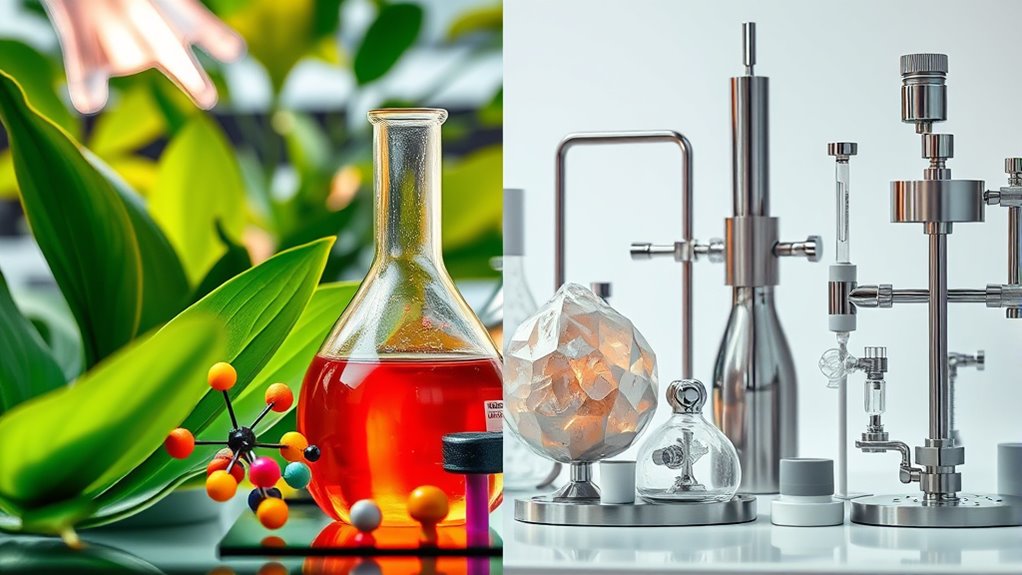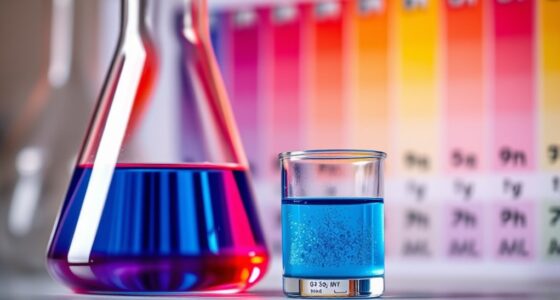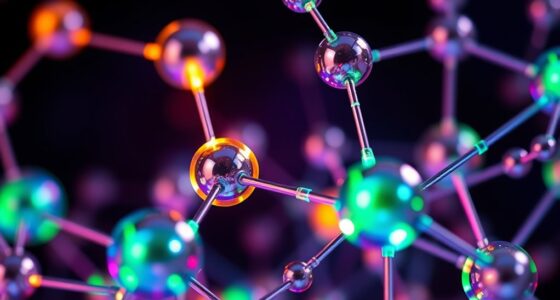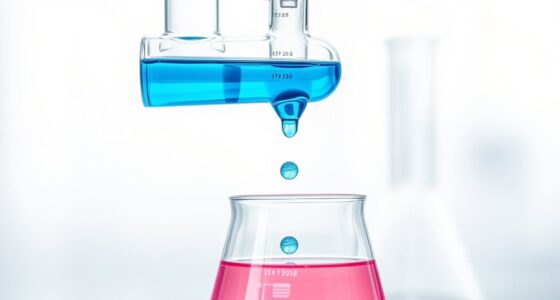Organic chemistry focuses on compounds mainly made of carbon, hydrogen, oxygen, and nitrogen, often originating from living organisms. It involves covalent bonds and results in molecules that are flammable, less water-soluble, and lighter. Inorganic chemistry deals with metals, minerals, salts, and elements with ionic or metallic bonds, usually more stable and water-soluble. To understand how these fields compare in sources, properties, and uses, explore further to discover their unique roles.
Key Takeaways
- Organic chemistry focuses on carbon-containing compounds from living organisms, while inorganic chemistry deals with minerals, metals, and non-carbon compounds.
- Organic molecules are mainly covalent and less water-soluble; inorganic compounds often form ionic bonds and are water-soluble.
- Organic reactions typically require higher activation energy and involve complex mechanisms, unlike the faster ionic reactions in inorganic chemistry.
- Organic compounds are generally volatile, flammable, and less dense, whereas inorganic compounds tend to be dense, stable, and non-flammable.
- Applications differ: organic chemistry is key in pharmaceuticals and plastics, while inorganic chemistry is crucial for materials, catalysts, and construction.
Origins and Natural Sources of Organic and Inorganic Compounds

Understanding the origins and natural sources of organic and inorganic compounds reveals how they form and where they come from. Organic compounds mainly originate from living organisms or biological processes. You find them in plants, trees, and animals, which emit VOCs like isoprene and terpenoids. Soil and microorganisms also produce organic molecules, while marine life contributes unique compounds used in medicine. These biological processes are responsible for synthesizing many complex organic molecules essential for life. Petrochemicals, derived from hydrocarbons, are a significant source of synthetic organic compounds. In contrast, inorganic compounds come from mineral deposits, geological processes, and natural sources like seawater, rocks, and atmospheric gases. These compounds are often extracted or synthesized for industrial use. While organic sources are tied to biotic activities, inorganic sources are primarily abiotic, forming over long geological times or through natural environmental processes. Additionally, geological formations play a key role in the accumulation and concentration of inorganic minerals, further distinguishing their origins from organic materials.
Fundamental Differences in Composition and Elements
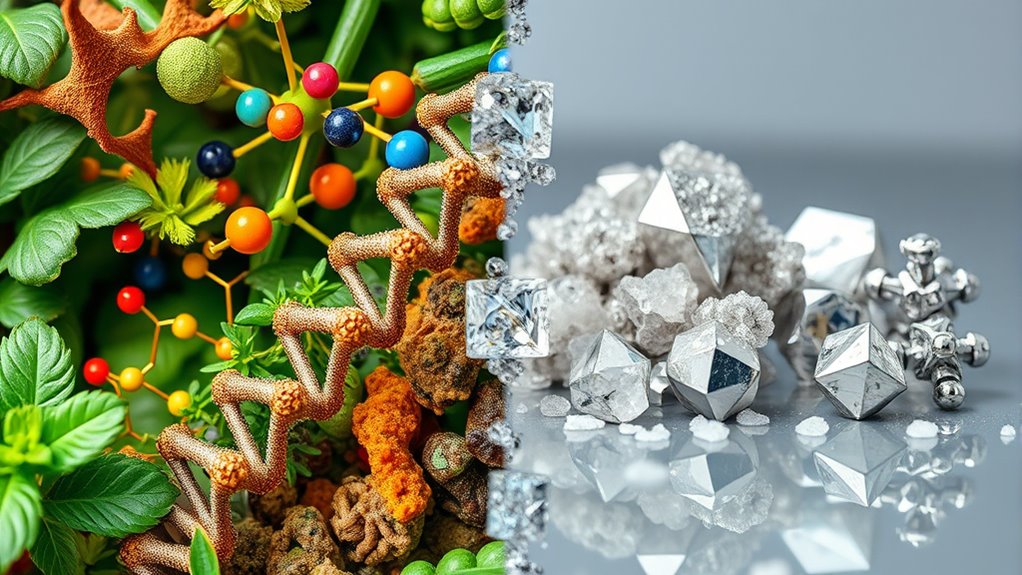
The origins and natural sources of organic and inorganic compounds reflect their fundamental differences in composition and elements. Organic compounds are characterized by the presence of carbon atoms, bonded mainly with hydrogen, oxygen, nitrogen, and sometimes halogens and phosphorus. These molecules tend to be complex, larger, and often contain multiple carbon-hydrogen bonds. Additionally, organic compounds are typically derived from living organisms or biological processes, emphasizing their biological origin and significance in life chemistry. In contrast, inorganic compounds can include nearly any element from the periodic table, such as metals and nonmetals, and are generally simpler in structure. Organic compounds are less soluble in water and more soluble in organic solvents, often exhibiting volatility and flammability.
Inorganic compounds, however, tend to be water-soluble, good conductors of heat and electricity, and are more reactive in forming salts and participating in various reactions.
Types of Chemical Bonds and Structural Characteristics
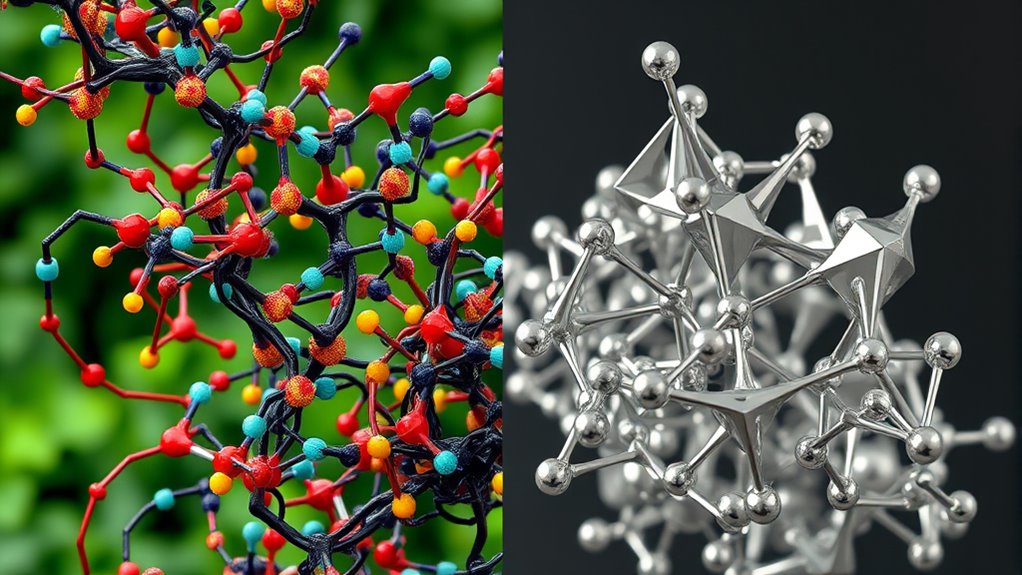
Chemical bonds determine the structure and properties of both organic and inorganic compounds. In organic chemistry, covalent bonds dominate, with electrons shared between carbon and other atoms, creating complex bonding patterns like sigma and pi bonds, which allow double and triple bonds. Quotes highlight the profound impact fathers have on children’s lives. In inorganic chemistry, ionic bonds often form, resulting from the electrostatic attraction between oppositely charged ions, producing crystalline lattices. Metallic bonds, characteristic of metals, involve delocalized electrons, giving metals their malleability and conductivity. Hydrogen bonds, though weaker, influence structures like DNA and water by enabling specific arrangements. Coordinate covalent bonds, where one atom supplies both electrons, appear in certain complex molecules. These bond types shape the structural characteristics, stability, and physical properties of compounds across both fields.
Variations in Physical Properties and States of Matter
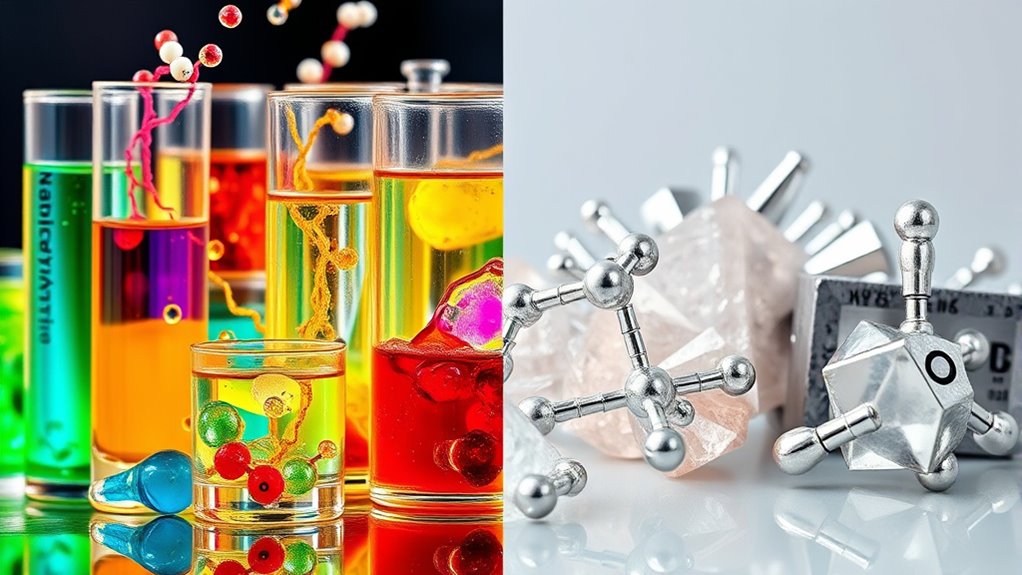
Organic compounds can exist in solid, liquid, or gaseous states at room temperature, demonstrating their versatility in physical form. You’ll notice they often have lower densities than inorganic compounds, which tend to be denser, thicker, and more rigid. Additionally, organic compounds frequently exhibit distinct spectral signatures, aiding in their identification and analysis. Organic materials generally have lower elastic moduli and less thermal stability, making them more flexible but less durable under heat. In regarding solubility, organic compounds are mostly insoluble in water but dissolve well in organic solvents like benzene or ether. Conversely, inorganic compounds are usually water-soluble due to their ionic nature, but insoluble in organic solvents. Organic compounds tend to be more volatile and flammable because of their covalent bonds, while inorganic compounds are typically non-volatile, non-flammable, and possess higher thermal stability.
Typical Reaction Rates and Chemical Reactivity
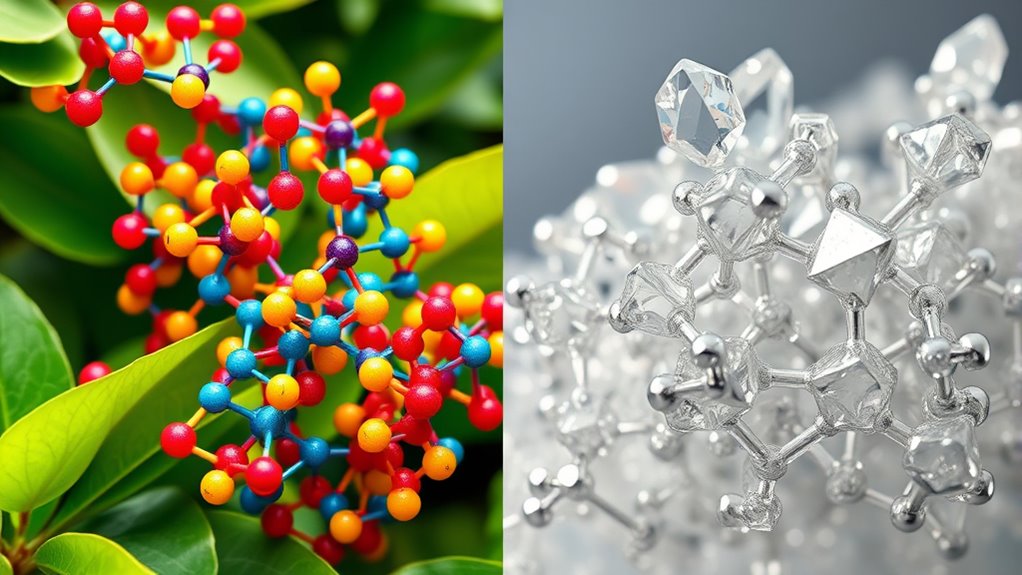
Reaction rates in organic and inorganic chemistry differ markedly due to their distinct bonding and structural characteristics.
Organic compounds mainly involve strong covalent bonds, which require higher activation energies to break, leading to slower reactions.
In contrast, inorganic compounds often feature ionic bonds that are easier to disrupt, resulting in faster reaction rates.
Organic reactions are highly influenced by molecular structure, steric effects, and electronic factors, which can either slow down or speed up the process.
Additionally, organic reactions tend to proceed through complex mechanisms involving intermediates like carbocations or radicals, adding to their slower kinetics.
The presence of catalysts and the reaction environment also significantly influence the reaction rates in both fields, but organic reactions usually demand more precise control due to their higher activation energies and intricate pathways. Understanding the causes and contributing factors behind these differences can help chemists optimize reaction conditions for desired outcomes.
Common Examples and Practical Applications
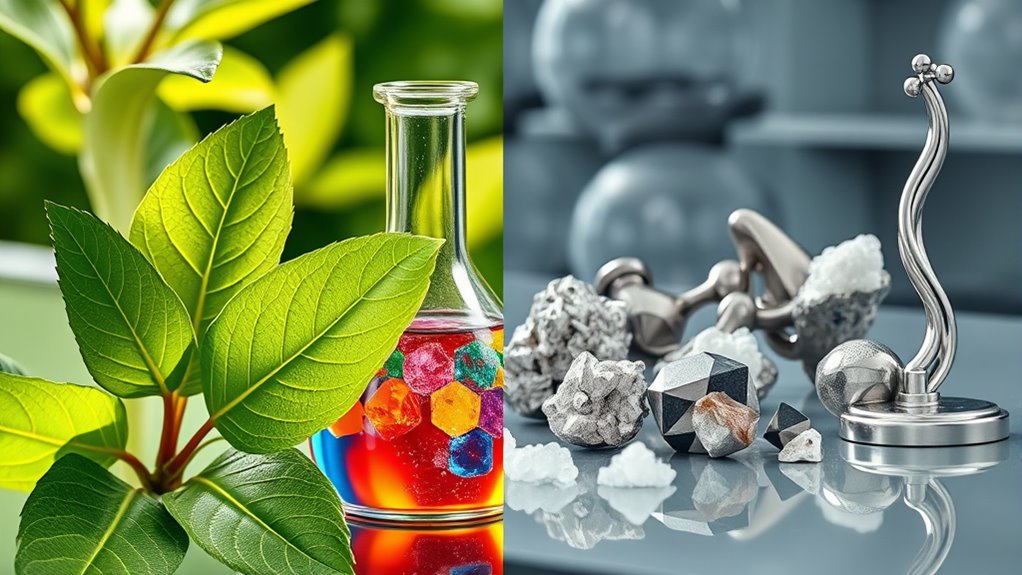
Many everyday products and industries rely on the principles of common examples and practical applications of chemistry. For example, polymers like nylon, PVC, and polyethylene are made through organic chemistry, while soaps, detergents, perfumes, and cosmetics depend on organic compounds.
Organic chemistry underpins many everyday products like plastics, soaps, perfumes, and cosmetics.
Food additives, preservatives, and flavor enhancers also involve organic chemistry, as do petrochemicals used for fuels and plastics. In practical applications, organic chemistry is crucial in developing pharmaceuticals, refining petroleum, manufacturing rubber and plastics, and enhancing food processing.
Organic compounds are also central to agricultural chemicals like insecticides and fertilizers. In contrast, inorganic chemistry focuses on metals, alloys, salts, and minerals, with applications in energy storage, construction materials, water purification, and environmental remediation.
Both fields are essential for modern industry and technology.
Roles in Biological Systems and Living Organisms

The compounds created through organic chemistry form the foundation of life’s molecular structure, shaping how living organisms function. You rely on organic molecules like proteins, lipids, and carbohydrates for cellular activities, energy production, and growth. DNA and RNA, essential for genetic information, are organic molecules that guide inheritance and cellular regulation. Energy transfer within cells depends heavily on ATP, an organic compound. Nutrients essential for your health are primarily organic, providing necessary building blocks and fuel. While inorganic elements like calcium and phosphorus support structural functions and signaling, organic molecules directly participate in biochemical processes. Additionally, understanding the supportive role of emotional well-being in maintaining overall health highlights the importance of mental health alongside physical health. Together, organic and inorganic components maintain biological functions, ensuring your body’s stability, growth, and overall health.
Solubility and Conductivity in Different Media

Solubility and conductivity of compounds vary considerably depending on their chemical nature and the medium they’re in. Organic compounds, with covalent bonds, generally have low solubility in water but dissolve well in non-polar solvents like hexane or benzene. Their molecules rarely dissociate into ions, leading to poor electrical conductivity. Electric power generation with bike generators demonstrates the importance of power output and efficiency, which are similarly affected by molecular structure and bonding in chemical compounds. In contrast, inorganic compounds, often ionic or metallic, dissolve easily in water and dissociate into ions, resulting in high conductivity. Their solubility typically increases with temperature, although exceptions exist. Organic compounds tend to act as insulators, whereas inorganic salts and metals facilitate the flow of electric charge. The type of bonding—covalent or ionic—dictates solubility and conductivity, shaping how these compounds interact across different media.
Impact on Industry and Technological Fields
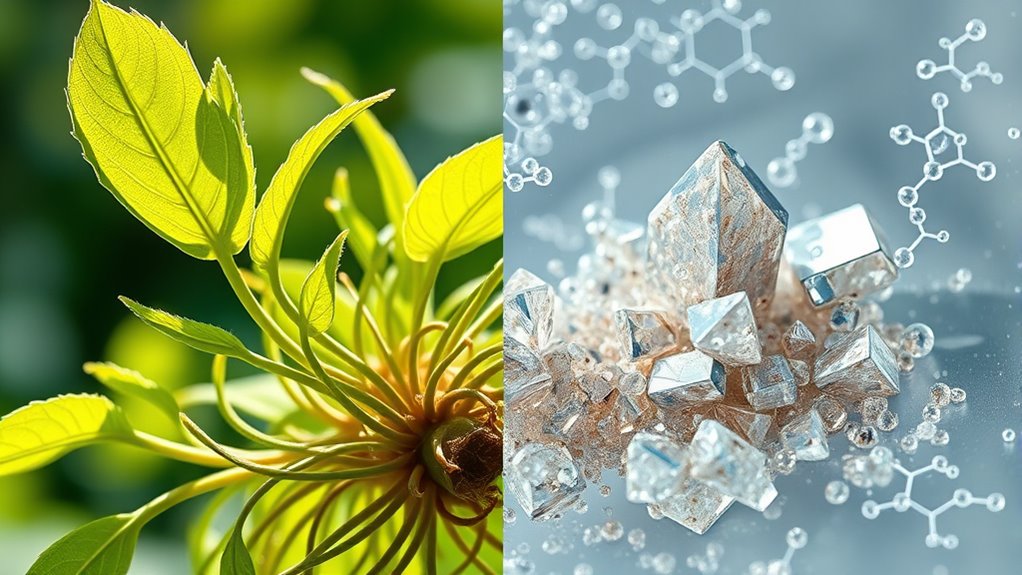
Inorganic compounds substantially influence industry and technological development due to their exceptional stability and durability. Their resistance to degradation makes them ideal for harsh environments, supporting applications in construction, energy, and transportation. Self watering plant pots exemplify the practical application of inorganic materials, showcasing their utility in everyday life. Large-scale production of inorganic compounds is more efficient, ensuring consistent quality and cost-effective supply, which helps meet global demands. They’re essential in manufacturing microchips, catalysts, sensors, and biomedical implants, thanks to their robustness and inert properties.
Organic compounds, while crucial in pharmaceuticals, plastics, and agrochemicals, often require complex synthesis, limiting scalability.
Inorganic materials like ceramics aid in environmental remediation and industrial processes.
Special Cases: Organometallic and Crossover Compounds

Organometallic and crossover compounds represent unique intersections between organic and inorganic chemistry, often bridging the gap between the two fields. You’ll find that organometallic compounds contain at least one bond between a metal and an organic carbon, exhibiting covalent, ionic, or delocalized bonds.
Organometallic compounds link organic and inorganic chemistry through covalent, ionic, or delocalized metal-carbon bonds.
Their reactivity depends on the metal’s reduction potential and the bond’s ionic character, while their physical properties vary—many are solids, but some with electropositive metals are volatile and toxic. Additionally, the trustworthiness of AI models like GPT-4 is continually assessed to ensure safety and reliability.
Crossover compounds blend features from both fields, used in synthesis and biological systems to harness combined benefits. Their properties depend on the specific organic-inorganic mix, making them versatile in catalysis, material science, and medicinal chemistry.
Their special reactivity, especially with highly electroactive metals, demands careful handling and low-temperature conditions.
Frequently Asked Questions
How Do Organic and Inorganic Chemistry Differ in Their Study Methods?
You study organic and inorganic chemistry differently through their unique methods.
In organic chemistry, you use advanced techniques like NMR spectroscopy, complex synthesis steps, and specific reagents to analyze and create carbon-based compounds.
In inorganic chemistry, you rely on simpler purification methods like crystallization, handle compounds carefully due to reactivity, and often focus on equilibrium reactions.
Your approach varies based on the type of compounds and reactions involved.
Are There Any Overlaps or Exceptions Between Organic and Inorganic Compounds?
Ever wonder if organic and inorganic compounds ever cross paths? You’ll find overlaps, like some inorganic compounds containing carbon, such as carbonates and cyanides.
Conversely, organic compounds can sometimes exhibit ionic bonds, especially in organometallics. While most differences are clear, these exceptions show that chemistry isn’t always black and white.
Recognizing these overlaps helps you understand the complexity and interconnectedness of chemical compounds better.
Why Do Organic Compounds Generally Have Lower Melting Points Than Inorganic Ones?
You might notice that organic compounds generally have lower melting points because their molecules rely on weaker intermolecular forces like London dispersion and dipole-dipole interactions. These forces are easier to break compared to the strong ionic bonds found in inorganic compounds.
As a result, organic compounds melt at lower temperatures, reflecting their molecular structures, which tend to be less symmetrical and less densely packed than inorganic solids.
How Does the Environmental Impact of Organic Compounds Compare to Inorganic?
You see, organic compounds like VOCs contribute to smog, global warming, and indoor air pollution, affecting plants, animals, and human health.
In contrast, inorganic compounds such as heavy metals and gases cause acid rain, soil and water contamination, and bioaccumulation, leading to long-term ecosystem damage.
While organics often decompose faster, inorganics persist, causing prolonged harm.
Both impact environments, but inorganic pollutants tend to have more lasting effects.
What Career Fields Primarily Utilize Organic Versus Inorganic Chemistry?
Ever wondered which careers lean more on organic or inorganic chemistry? You’ll find organic chemistry mainly in pharmaceuticals, biotech, food science, environmental solutions, and forensic analysis—where creating and studying carbon-based compounds is key.
In contrast, inorganic chemistry dominates materials science, nuclear tech, catalysis, geochemistry, and electronics—focusing on metals, minerals, and complex inorganic structures.
Both fields overlap in advanced materials, energy, and environmental efforts, shaping many innovative industries.
Conclusion
Understanding the differences between organic and inorganic chemistry helps you see how each field shapes our world. Did you know that organic compounds make up over 90% of known chemicals, including all life forms? Recognizing their unique properties and roles allows you to appreciate their impact—from medicines to materials. So, whether you’re exploring biological systems or industrial processes, knowing these differences gives you a powerful perspective on the chemistry that surrounds you daily.
